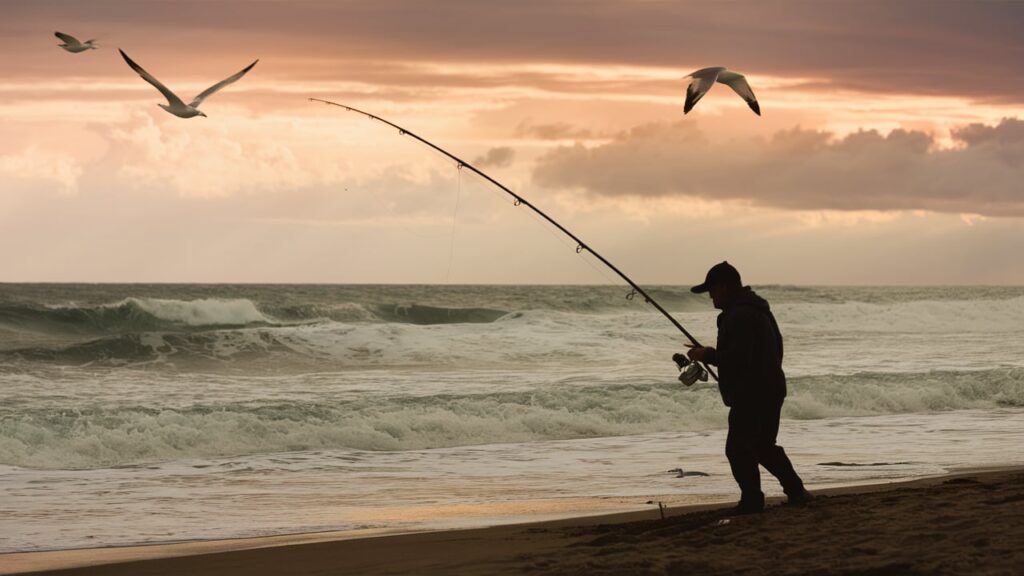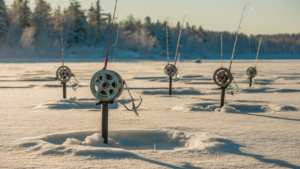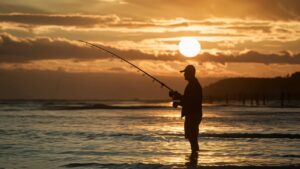To surf fish effectively, you need the right amount of fishing line. Generally, 200 to 300 yards is enough for most surf fishing situations.
Recommended Best Surf Fishing Line 2025
| Recommendation | Product |
| Best Overall | Beyond Braid Braided Fishing Line |
| Popular Choice | Power Pro Spectra Fiber Braided Fishing Line |
| Best Value | KastKing SuperPower Braided Fishing Line |
| Best Budget | Reaction Tackle Braided Fishing Line |
| Another Excellent Pick | RIKIMARU Braided Fishing Line |
But, it depends on various factors like the type of fish, surf conditions, and your fishing gear. Surf fishing is an exciting way to catch big fish from the shore. But to succeed, you need the right setup, including the correct line length.
Too little line, and you risk losing fish; too much, and it becomes unmanageable. In this post, we’ll explore how to determine the perfect amount of line for your surf fishing adventures. We’ll discuss key factors like fish size, surf conditions, and reel capacity. By understanding these elements, you can improve your chances of a successful and enjoyable fishing trip.
Type Of Fish
Choosing the right amount of fishing line for surf fishing depends on the type of fish you aim to catch. Different fish species require different line strengths and lengths. Understanding these needs helps you prepare better and increases your chances of success.
Common Surf Fish Species
Many fish species can be caught while surf fishing. Some common ones include striped bass, redfish, flounder, and bluefish. Each has unique behaviors and habitats, influencing your line choice.
Line Requirements For Each Species
For striped bass, a line of 200 to 300 yards works best. These fish are strong fighters and can pull a lot of line.
Redfish need a similar setup. Using 200 to 300 yards of line ensures you can handle their power and speed.
Flounder are less demanding. A line of 150 to 200 yards is usually sufficient. They stay close to the bottom and don’t pull as much line.
Bluefish are known for their aggressive nature. Using 250 to 300 yards of line gives you a good chance to manage their sudden runs.

Fishing Conditions
When it comes to surf fishing, the conditions can make or break your day. Understanding the different factors that influence your fishing trip is key. Let’s dive into some of the most important ones: the weather, water depth, and currents.
Weather Influence
Weather plays a massive role in surf fishing. It’s not just about whether you need a raincoat. For instance, bright sunny days can make fish more visible, but they might also spook easier. Cloudy days can be your best friend, offering better cover and making fish less wary.
Wind direction and speed also matter. A gentle breeze can help you cast further, but strong winds might turn your line into a tangled mess. Trust me, nobody wants to spend their fishing trip untangling line. Always check the forecast before heading out.
Water Depth And Current
Water depth and currents are other critical factors. Deeper water generally means more line is needed. If you’re fishing in shallow water, you might not need as much. However, if the current is strong, you’ll need more line to ensure your bait stays put.
Currents can also affect the type of fish you’ll encounter. Some fish love a strong current, while others prefer calmer waters. Understanding your target species and their preferred conditions can help you choose the right amount of line.
Consider making a table like this to keep track of your findings:
| Condition | Impact |
|---|---|
| Sunny Weather | Fish are more visible but cautious |
| Cloudy Weather | Better cover, fish are less wary |
| Strong Wind | Harder to cast, risk of tangled line |
| Gentle Breeze | Easier to cast further |
| Deep Water | More line needed |
| Strong Current | More line needed to keep bait steady |
In conclusion, always factor in the weather, water depth, and current when deciding how many yards of line to use for surf fishing. These conditions can vary greatly, and being prepared will help you have a successful and enjoyable fishing trip.
Type Of Reel
Choosing the right reel is crucial for surf fishing success. The type of reel you use affects how much line you need. Understanding the differences between spinning reels and conventional reels can help you make an informed decision. Let’s dive into the details of each type.
Spinning Reels
Spinning reels are popular for surf fishing. They are user-friendly and versatile. These reels can hold a significant amount of line. Ideal for beginners, spinning reels are less prone to tangles. They offer excellent casting distance and control. For surf fishing, you typically need 200 to 300 yards of line on a spinning reel. This ensures you have enough line to handle big fish and strong currents.
Conventional Reels
Conventional reels offer more power and line capacity. Experienced anglers often prefer them. These reels are suitable for targeting large fish species. Conventional reels can hold up to 500 yards of line. This is beneficial for deep waters and long-distance casting. They require skill to operate but reward with better control and strength. For surf fishing, conventional reels give you an advantage in challenging conditions.
Line Material
Choosing the right line material is vital for surf fishing. The line affects casting distance, sensitivity, and strength. Different materials offer unique benefits. Understanding these can help improve your fishing experience.
Monofilament
Monofilament is a popular choice among anglers. It’s made from a single fiber of plastic. This material is flexible and stretches under tension. This can be helpful when fighting a fish. It’s easy to handle and knot. It also offers good abrasion resistance.
Monofilament is affordable and widely available. Its main drawback is that it tends to weaken over time. Sun exposure and water absorption can degrade it. Regular replacement is necessary to maintain performance.
Braided Line
Braided line is another excellent option. It’s made from woven fibers, creating a strong and thin line. This material offers little to no stretch. This increases sensitivity and allows for better hook sets. It also has a small diameter, which helps with casting distance.
Braided line is highly durable and long-lasting. It doesn’t degrade as quickly as monofilament. One downside is that it’s more visible in the water. Fish can sometimes see it, making them wary. Adding a leader can help with this issue.
Casting Techniques
Understanding casting techniques is essential for surf fishing. The right technique helps you reach the desired distance and improves your chances of catching fish. Here, we will discuss two main casting techniques: long casting and short casting. Each method has its own advantages and applications.
Long Casting
Long casting is ideal for reaching distant waters where fish are often found. This technique requires a powerful throw. Use a long surf rod, typically around 10 to 12 feet. This rod length allows for greater leverage and distance.
To perform a long cast, start with a strong stance. Hold the rod with both hands. Swing the rod backward, then forward in a smooth motion. Release the line at the right moment to maximize distance. Practice helps improve accuracy and distance. Long casting works well in open beaches with few obstacles.
Short Casting
Short casting is useful in areas with nearby structures or surf zones. It requires less effort and is easier to control. Use a shorter rod, around 7 to 9 feet. This rod length offers more control and precision.
For a short cast, stand with your feet shoulder-width apart. Hold the rod firmly with both hands. Swing the rod backward gently, then forward. Release the line smoothly. Short casting is effective in rocky areas or near piers. It allows you to target specific spots with more accuracy.
Expert Tips
Surf fishing can be thrilling. But how many yards of line do you need? It depends on many factors. Here are expert tips to help you make the right decision.
Choosing The Right Line
The type of fish you target matters. For small fish, 200 yards may be enough. For larger fish, consider 300 to 400 yards. The line’s strength is crucial too. Use a stronger line for rough waters. A lighter line suits calm waters better. The line material also plays a role. Monofilament is good for beginners. Braided line offers more strength. Fluorocarbon is nearly invisible underwater. Choose based on your experience and needs.
Maintaining Your Line
Proper maintenance extends your line’s life. Rinse your line after each use. Saltwater can damage it quickly. Check for frays and nicks regularly. Damaged lines break easily. Store your reel in a cool, dry place. Avoid direct sunlight. UV rays weaken the line. Replace your line yearly. Frequent use may require more frequent changes. Always keep extra line in your tackle box. You never know when you might need it.
Frequently Asked Questions
Is 150 Yards Of Braid Enough For Surf Fishing?
Yes, 150 yards of braid is usually enough for surf fishing. It provides sufficient line for casting and handling fish.
How Many Yards Of Line Do I Need For Surf Fishing?
For surf fishing, you typically need 250-300 yards of line. This ensures you can handle long casts and big fish.
How Much Line To Put On A Surf Reel?
Fill your surf reel with line up to 1/8 inch below the spool’s rim. This ensures optimal casting performance.
Is A 20lb Line Good For Surf Fishing?
Yes, a 20lb line is good for surf fishing. It provides a balance between strength and casting distance.
Conclusion
Choosing the right line length is key for successful surf fishing. Consider your target fish, fishing conditions, and reel size. Typically, 200-300 yards suffice. Adjust based on your needs. Always prepare for unexpected big catches. Happy fishing and tight lines!








